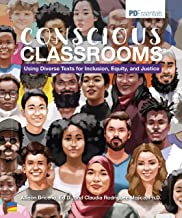Conscious Classrooms
Using Diverse Texts for Inclusion, Equity, and Justice
“Children Need Models More Than Critics”
French Proverb
Allison Briceño and Claudia Rodriquez-Mojica have collected a wide variety of resources for educators. This book will save you TIME and provide useful templates for teachers and staff to use. Our schools and communities will continue to be more diverse. Equity will be a potential issue if we continue to use historical models and assume they will suffice in a changing world.
Dealing with COVID, advances in technology, changing demographics, etc. will require new modeling and models while keeping some of the practices that have worked. One example for me, as a former science teacher, is labs were always part of my teaching. Motors skills were developed as part of those labs. Now, most things can be represented via technology. Content may be understood but the dexterity and motor skills are at risk.
On page 8 of their book, Putting It into Perspective is an important beginning. These facts highlight some of the rethinking that will be needed in the future.
I liked the way the book is organized to help us. There are ‘Big Idea’ sections, ‘Tool to Try,’ ‘Voices from the Field,’ and my favorite is READ THIS. The READ THIS! Section included in every chapter gives specific articles and excerpts to explore, extend, and energize our learning.
Another helpful part of this book is the templates provided to help assess where we are and what we might consider for the future. These templates are another example of how this book can save valuable time in our collaborative teams.
Chapter 7 gives strategies for communicating with parents, community, and administrators. These are practical ways of letting stakeholders know about inclusion and equity knowledge to increase support for diversity and justice.
If inclusion, equity, and justice is your goal for students (and community), I highly recommend this book.

